How to make herb vinegars
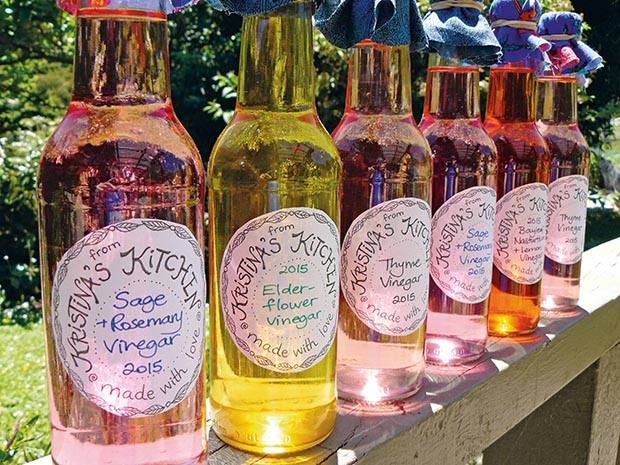
These vinegars look fantastic, taste great, and are very easy to make.
Words: Kristina Jensen
A friend of mine asked me a couple of months ago where I found time to ‘do all these things’. By ‘all these things’ she was referring to a bottle of sage and rosemary vinegar that I had given her as a Christmas present. I struggled for an answer because for me this has become a routine thing, a habit partly handed down from Mum who was a great believer in ‘making it yourself’.
Every year around now, when plants start to go to seed, I start making vinegars from the flowering stalks, especially basil, coriander and dill. My friend’s question got me thinking about how perhaps other people would like to give a DIY gift, and so I felt compelled to suggest to anyone who feels that they just don’t have time to make home-made gifts that herb vinegars are a good place to start. Why?
Basically you pick a handful or two of herbal or floral material, pop it in a jar, cover it with vinegar and walk away, leaving it in a dark, cool spot to steep happily for 2-4 weeks. The acidity of the vinegar breaks through the cell walls of the infused matter, encouraging the release of the wonderful aromas and flavours into the jar. Then it’s a simple matter of straining off the liquid and bottling your now deliciously fragrant, tasty and attractively-coloured vinegar, labelling it, then giving it away. Another reason I like them? It’s got to do with money. You know where it says in my bio at the end of this article, ‘she sidesteps the supermarket’ – this is a prime example, just in case you wondered what that actually means in real life.
You have probably seen herb vinegars in up-market boutique shops. They look amazing, packaged in glamorous bottles with waxed seals, with bright red chillies and garlic cloves floating serenely in the depths. Amazing until you see the price! I’ll let you in on a little secret here: vinegar is cheap. I buy mine in 5-10 litre containers from wholesalers so the cost plummets to around $1- $2/litre. Bottles are easy to find and if you keep your recycling eyes open, you can build up a wee collection of interestingly-shaped ones in which to display your home-made vinegars. Herbal vinegars are also multi-talented.
You can infuse herbs in vinegar for culinary, cosmetic and medicinal use, and even for household cleaning. My favourite ways to use herb vinegars are as key ingredients in winter crockpot stews, in salad dressings and as a remedy for sore throats.
Herb vinegars add the most delightful flavours and provide the all-important ‘acidity regulator’ factor that you will see on many food labels. Most of the time, ‘acidity regulator’ refers to vinegar and if your stew or soup doesn’t taste quite right, try adding 1-2 tbsp of vinegar. It’s one of those tastes that really enhances the flavour of food and one that certain people crave, hence why we love salt and vinegar chips.
KRISTINA’S 7 TIPS TO GREAT VINEGARS
1. Keep your jars of gently infusing material in a dark cool place – too much direct light and the vinegar will go cloudy.
2. Harvesting your own herbs is the best, but if you need to gather material from elsewhere, make sure it isn’t sprayed or near a spray zone.
3. Experiment with combinations. One of my favourite is elderflowers, peppercorns, chive flowers and garlic, and one I’m going to try this year is pineapple sage, cranberries, ginger and garlic.
4. Use glass containers and non-metallic stoppers and tools to prepare or store vinegar.
5. Never use ground spices or herbs as this also makes the vinegar cloudy.
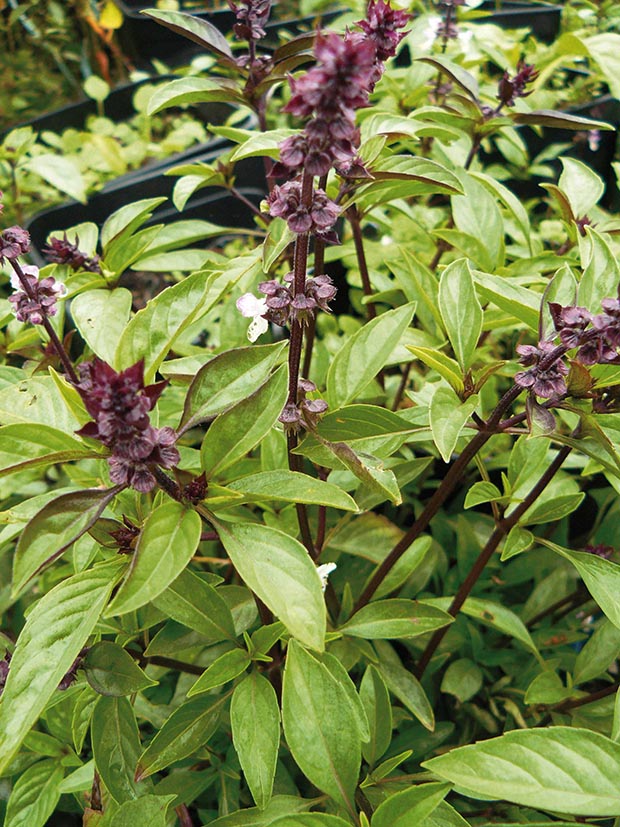
Basil.
6. You can add whole red chillies, ginger root, garlic cloves, bay leaves and peppercorns to your vinegars too, but unlike the fresh herbal or fl oral material, you can leave these items in the vinegar for stunning visual effect.
7. A fresh sprig of the herb used can be inserted into the bottle after you strain it if you wish.
HOW TO COLOUR YOUR VINEGAR
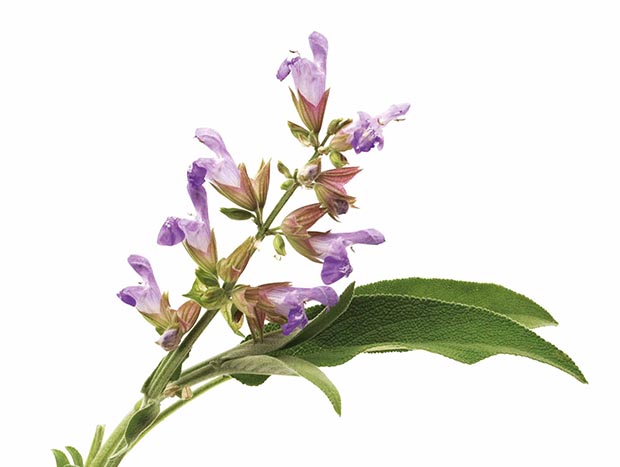
The colour will be stronger if you use white vinegar or white wine vinegar.
Orange and Yellow: elderflowers, calendula, dill or nasturtium flowers
Purple: sage or rosemary flowers
Pink/Red: pineapple sage, thyme, chive or oregano flowers, opal basil
Pale Green/Greenish Yellow: dill, parsley, mint, tarragon, coriander or summer savoury leaves
HOW TO COOK WITH HERBAL VINEGARS
Herb vinegars can be used in cooking in equal amounts where wine, fruit juice, plain vinegar, lemon or lime juice is called for.
-Mint vinegar is great with lamb dishes and on fruit salad.
-Thyme and sage vinegars are indispensable in meaty stews and marinades.
-For sore throats, add a tablespoon each of thyme and sage vinegar to a small teapot containing hot water into which 2 tsp of honey have been dissolved. Cool, then sip when required. It’s a strong taste but it works every time for me.
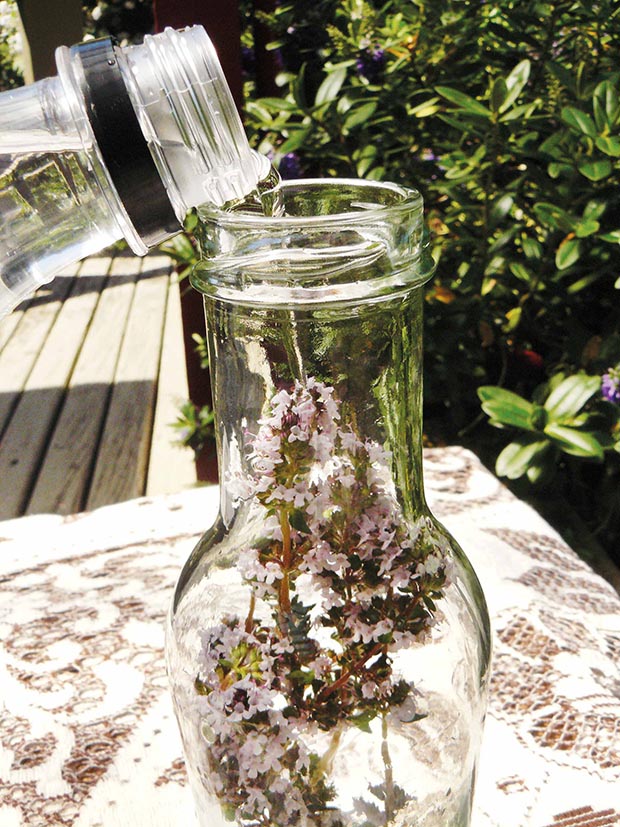
-Salad burnett vinegar gives salad dressing a cucumber taste.
-Lemon balm and lemon thyme impart a citrus taste. Sprinkle a roast chicken with lemon thyme vinegar before baking, or add it to the stuffing.
-Tarragon vinegar is excellent with chicken. Add it to gravy, dips for chicken nuggets, use as a marinade, or sprinkle onto fried chicken.
-Dill vinegar is especially good with fish or in mayonnaise and salad dressing.
-Basil vinegar is perfect for dressing a Greek salad.
-Rosemary vinegar made with apple cider vinegar is a good rinse for the scalp, helping to combat dandruff and stimulating healthy hair growth. Sprinkle over cooked roast veges and chips, use to marinate venison, and add a dash to gravy for pork or chicken.
-Make home-made barbecue sauce with vinegar – add chillies, bay leaves, peppercorns and garlic cloves for a fantastic zing.
Recipe: Herbal Vinegar
INGREDIENTS
vinegar
herbs and/or flowers
METHOD
For one litre of vinegar, you will need two large handfuls of herbs and/or flowers, and a sterilised Agee or Mason jar with a plastic lid (or equivalent). Remove any dirt or unsightly debris and use only the best leaves and flowers. Pack the herbs and/or flowers into the jar, cover with vinegar and pop the lid on. Put in a dark cool place for 2-4 weeks. Invert the jar once or twice during that time to move the material around in the vinegar.
Strain off the liquid, label it and it’s done – you’re all ready to package it up as gifts (if you don’t use it all up yourself!). Some folks say use the vinegar up within three months but I have found that in an airtight bottle, the flavours are still very much alive and kicking after a year, even two.
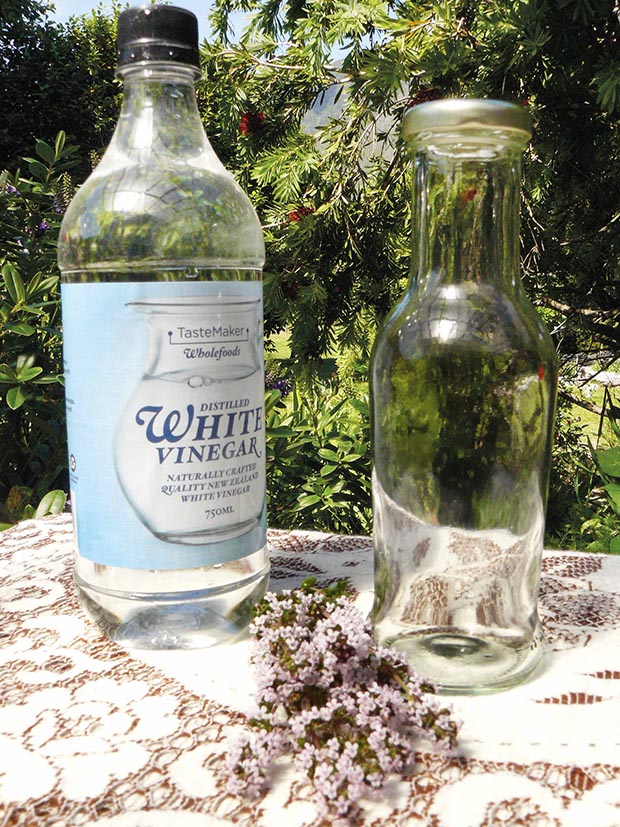
Love this story? Subscribe now!
 This article first appeared in NZ Lifestyle Block Magazine.
This article first appeared in NZ Lifestyle Block Magazine.
